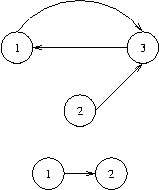POJ 2553 The Bottom of a Graph
Description
We will use the following (standard) definitions from graph theory. Let
V be a nonempty and finite set, its elements being called vertices (or nodes). Let
E be a subset of the Cartesian product
V×V, its elements being called edges. Then
G=(V,E) is called a directed graph.
Let n be a positive integer, and let p=(e1,...,en) be a sequence of length n of edges ei∈E such that ei=(vi,vi+1) for a sequence of vertices (v1,...,vn+1). Then p is called a path from vertex v1 to vertex vn+1 in G and we say that vn+1 is reachable from v1, writing (v1→vn+1).
Here are some new definitions. A node v in a graph G=(V,E) is called a sink, if for every node w in G that is reachable from v, v is also reachable from w. The bottom of a graph is the subset of all nodes that are sinks, i.e., bottom(G)={v∈V|∀w∈V:(v→w)⇒(w→v)}. You have to calculate the bottom of certain graphs.
Let n be a positive integer, and let p=(e1,...,en) be a sequence of length n of edges ei∈E such that ei=(vi,vi+1) for a sequence of vertices (v1,...,vn+1). Then p is called a path from vertex v1 to vertex vn+1 in G and we say that vn+1 is reachable from v1, writing (v1→vn+1).
Here are some new definitions. A node v in a graph G=(V,E) is called a sink, if for every node w in G that is reachable from v, v is also reachable from w. The bottom of a graph is the subset of all nodes that are sinks, i.e., bottom(G)={v∈V|∀w∈V:(v→w)⇒(w→v)}. You have to calculate the bottom of certain graphs.
Input
The input contains several test cases, each of which corresponds to a directed graph
G. Each test case starts with an integer number
v, denoting the number of vertices of
G=(V,E), where the vertices will be identified by the integer numbers in the set
V={1,...,v}. You may assume that
1<=v<=5000. That is followed by a non-negative integer
e and, thereafter,
e pairs of vertex identifiers
v1,w1,...,ve,we with the meaning that
(vi,wi)∈E. There are no edges other than specified by these pairs. The last test case is followed by a zero.
Output
For each test case output the bottom of the specified graph on a single line. To this end, print the numbers of all nodes that are sinks in sorted order separated by a single space character. If the bottom is empty, print an empty line.


Sample Input
3 3 1 3 2 3 3 1 2 1 1 2 0
Sample Output
1 3 2
Source
题意:求没有出度的强连通分量的点。
#include <stdio.h> #include <string.h> #define MAXN 5001 int m; int cnt; struct node{ int to,next; }edge[MAXN*MAXN]; int temp[MAXN]; int head[MAXN]; int dfn[MAXN]; int low[MAXN]; int sta[MAXN]; int flag[MAXN]; void addedge(int u, int v){ edge[cnt].to=v; edge[cnt].next=head[u]; head[u]=cnt++; } int min(int a, int b){ if(a<b)return a; else return b; } int tarbfs(int k ,int lay, int& scc_num){ temp[k]=1; low[k]=lay; dfn[k]=lay; sta[++m]=k; for(int i=head[k]; i!=-1; i=edge[i].next){ if(temp[edge[i].to]==0){ tarbfs(edge[i].to,++lay,scc_num); } if(temp[edge[i].to]==1)low[k]=min(low[k],low[edge[i].to]); } if(dfn[k]==low[k]){ ++scc_num; do{ low[sta[m]]=scc_num; temp[sta[m]]=2; }while(sta[m--]!=k); } return 0; } int tarjan(int n){ int scc_num=0; int lay=1; m=0; memset(temp,0,sizeof(temp)); memset(low,0,sizeof(low)); for(int i=1; i<=n; i++){ if(temp[i]==0)tarbfs(i,lay,scc_num); } return scc_num; } int main(int argc, char *argv[]) { int n,t,v,u; cnt=0; while(scanf("%d",&n),n){ scanf("%d",&t); memset(head,-1,sizeof(head)); memset(flag,0,sizeof(flag)); for(int i=0; i<t; i++){ scanf("%d %d",&v,&u); addedge(v,u); } tarjan(n); for(int i=1; i<=n; i++){ for(int j=head[i]; j!=-1; j=edge[j].next){ if(low[edge[j].to]!=low[i]){ flag[low[i]]=1; break; } } } for(int i=1; i<=n; i++){ if(!flag[low[i]]){ if(i!=n){ printf("%d ",i); }else{ printf("%d",i); } } } printf("\n"); } return 0; }